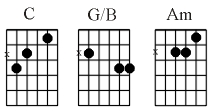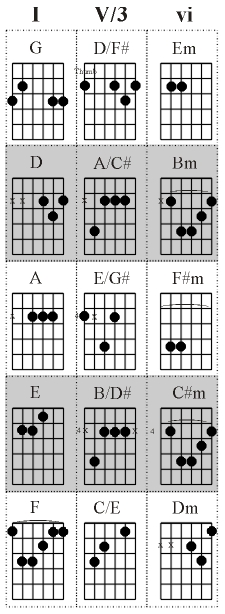A bass line progression is a progression where the bass note of a chord (“the lowest note played in a chord”) is changing and following a predetermined or predictable pattern. There are two generic types of bass line chord progressions: ascending (the bass line goes higher in pitch) and descending (the bass line goes lower in pitch). The bass line progressions can be pictured as going up or down a small set of stairs.
Root Note is Usually the Bass Note
One thing to understand first, is when any chord is being played, it’s bass note (or lowest note) is the root note of the chord (unless we are told otherwise). Thus the bass note of a G chord, a Gsus, a Gm7, a Gdim, etc. is a “G” note. If we need to change the bass note of a G major chord to a B, for example, we would write it kind of like a fraction: G/B. We often call these “slash” chords. The Dm7 chord with a C note in the bass would be written ‘Dm7/C’. An A7 with a C# note in the bass would be written ‘A7/C#’.
A common bass line progression occurs with a I chord (the root chord) and the vi chord (it’s relative minor). For example, the C chord’s relative minor is Am. C is the I chord and Am is the vi chord. But there often is a transition chord played between these two chords: the V chord with its 3rd note in the bass, or V/3. The V chord in the key of C is G major, and G’s 3rd note is B, thus we have G/B. Our progression could look like this:
| I | V/3 | vi |
| C | G/B | Am |
This is a descending bass line progression. The bass line follows the notes of the C major scale in descending pitch: C, then B, then A. We could follow this I – V/3 – vi in any key, and the pattern would sound the same. Look at the following chart:
You can reverse the order of this pattern to create an ascending bass line progression: vi – V/3 – I.
The next section will cover ways this progression is extended beyond these three chords.




I love this